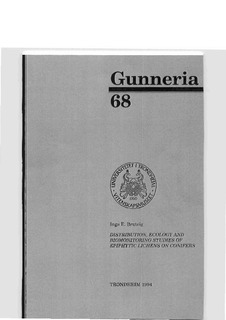| dc.contributor.author | Bruteig, Inga E. | nb_NO |
| dc.date.accessioned | 2014-12-19T14:49:41Z | |
| dc.date.available | 2014-12-19T14:49:41Z | |
| dc.date.created | 2010-07-28 | nb_NO |
| dc.date.issued | 1994 | nb_NO |
| dc.identifier | 331901 | nb_NO |
| dc.identifier.isbn | 82-7126-499-0 | nb_NO |
| dc.identifier.uri | http://hdl.handle.net/11250/273034 | |
| dc.description.abstract | This study presents the results of investigations of epiphytic lichens on conifers, mainly with a biomonitoring approach. The concentrations of nitrogen and sulphur measured in Hypogynmia physodes at 179 sites on a national grid net were related to estimates of the deposition of these two elements. The influence of climatic factors on lichen growth and nutrient status is discussed. Seven lichen species or groups of species growing on trunks of Pinus sylvestris have been mapped at 193 sites in the same monitoring network. A measuring tape technique was used for abundance estimates. Distributional patterns have been interpreted using multivariate techniques. Climatic parameters summarized in north-south, inland-coast and high-Iow altitude gradients are ascribed a major influence on variations in the epiphytic lichen vegetation. Lichens on Picea abies branches have been mapped in detail in coniferous forests in Hølylandet, central Norway and Åmli and Gjerstad, southern Norway. Major differences have been found between these areas as regards species composition, lichen abundance and the proportion of thalli with visible morphological damage. Using direct gradient analysis along P. abies branches, epiphytic lichens have been classified as generalists and broad or narrow specialists. Indications of interspecific associations have been found. Whether there is competition for space is discussed. The problem of discriminating between the effects of air pollution and closely correlated climatic factors is considered. The validity of using space-for-time substitution as a biomonitoring technique when two climatically different areas are being compared is questioned. The importance of using objective methods to quantify abundance in biomonitoring studies is emphasized. | nb_NO |
| dc.language | eng | nb_NO |
| dc.publisher | NTNU Vitenskapsmuseet | nb_NO |
| dc.relation.ispartofseries | Gunneria, 0332-8554; 68 | nb_NO |
| dc.title | Distribution, ecology and biomonitoring studies of epiphytic lichens on conifers | nb_NO |
| dc.type | Research report | nb_NO |
| dc.source.pagenumber | 24 | nb_NO |
| dc.contributor.department | Norges teknisk-naturvitenskapelige universitet, Vitenskapsmuseet, Seksjon for naturhistorie | nb_NO |
